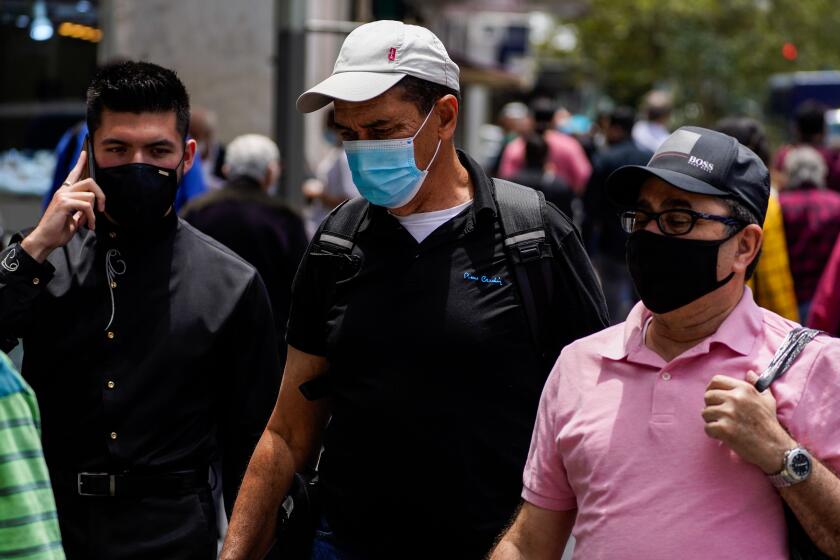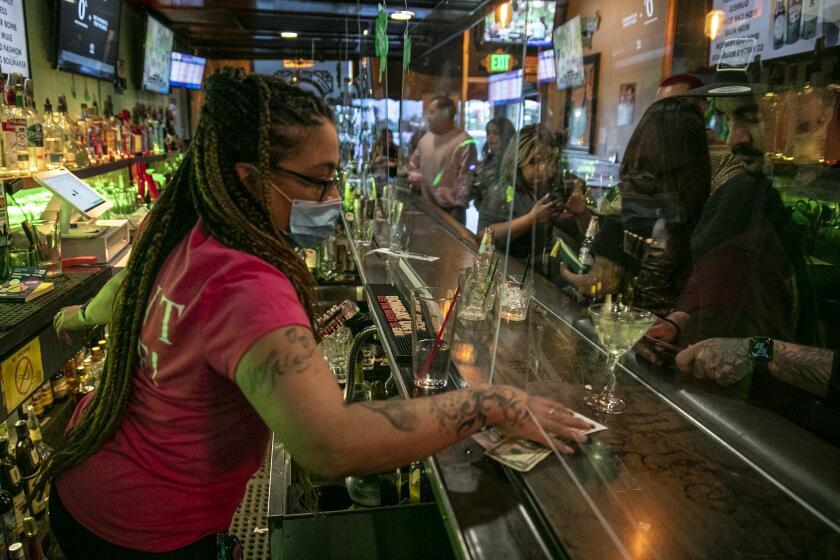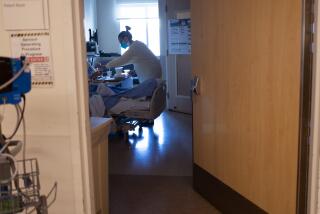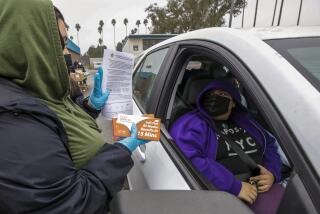L.A. County coronavirus cases surge past 100,000 with record one-day tally
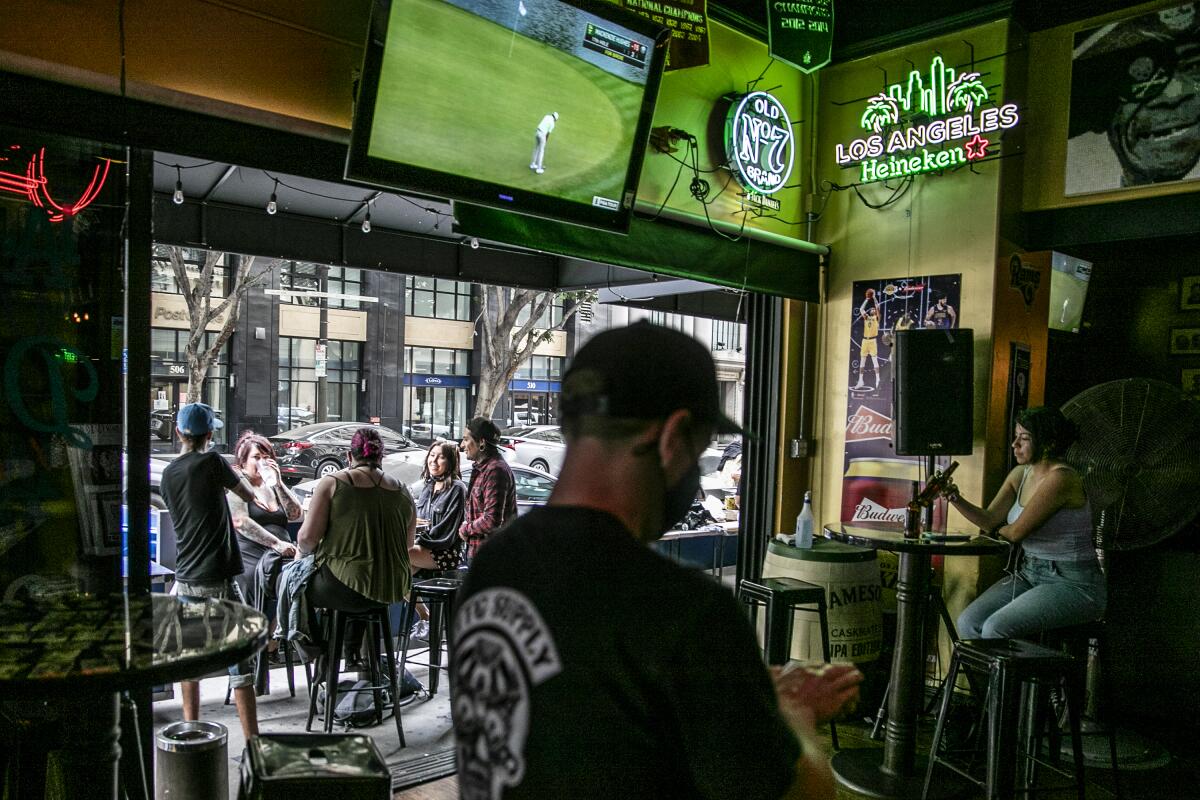
- Share via
Los Angeles County confirmed 22 additional coronavirus-related deaths and 2,903 new COVID-19 cases Monday, the largest single-day number of new infections the county has reported since the pandemic hit the U.S.
The daily tally brings the total number of coronavirus cases in L.A. County to more than 100,000.
The alarming spike in cases is not just the result of increased testing, county Public Health Director Barbara Ferrer said. The surge is proof that community transmission has “definitively” increased, with the rate of those testing positive for infection nearing 9%. Officials are now warning that 1 in 140 residents are likely unknowingly infected with the virus, a huge increase over last week’s projection of 1 in 400.
This is the scenario that L.A. County health officials most feared — that reopening would coincide with sudden jumps in coronavirus transmission.
In addition, health officials revealed that on June 20 — after Los Angeles County gave the green light for bars, breweries, wineries and similar businesses to reopen — more than 500,000 people visited the county’s newly reopened nightlife spots.
Officials said that 49% of bars and 33% of restaurants in the county were not adhering to social distancing protocols in the last week. Additionally, inspectors found that workers at 54% of bars and 44% of restaurants were not wearing face masks or shields.
“There are a number of businesses and individuals who have not followed the directives, and they’ve gone back to living like COVID-19 is not living in our community,” Ferrer said. “If you’re not part of the solution to slow the spread, you’re ending up being part of the problem.”
There are more than 40,000 restaurants in L.A. County. Of those, Ferrer said that roughly 3,000 have been inspected for COVID-19 protocols. Officials are starting with places that have had past citations, and are trying to reach every part of the county, but the order of inspection is fairly random.
The news follows the state’s order that seven counties — including Los Angeles — must close their bars, while eight others were encouraged to follow suit.
Gov. Gavin Newsom said the state is prepared to reinstate restrictions of his stay-at-home order as cases of the coronavirus continue to increase in California.
Across the state, infections have increased by 45% over the past 14 days, and hospitalizations have grow by 43%.
Officials have previously said that the increase in COVID-19 infections is “highly likely” the result of people gathering en masse at protests over the death of George Floyd, in addition to clusters of people who have congregated in restaurants and at private gatherings.
But because contact tracers do not identify cases that have stemmed from public spaces, it is often impossible to know the origin of transmission. Still, Gov. Gavin Newsom said Monday that the surge in cases was caused largely “by people mixing that were otherwise not mixing in the past,” before the state allowed the further reopening of select businesses.
And the spike is occurring statewide. Orange County confirmed 56 coronavirus-related deaths last week, the highest weekly death toll that the county has reported since the pandemic began in the U.S.
According to the California Department of Public Health, which collects information from each county’s distinct tracking methods, the biggest spike in cases and deaths occurred Wednesday, when 733 new cases and 24 deaths were reported.
With the spike in deaths and cases in Orange County — which has the third-most cases in the state — Newsom announced Monday that it had been added to the list of counties, now numbering 19, that the state was watching for surges in infection numbers or hospitalization rates.
The Memorial Day weekend appears to have been the turning point that pushed California into the coronavirus surge it’s seeing now.
While Orange County continues to move forward with its expanded reopening, other parts of California are scaling back as the state inches closer to crossing 6,000 deaths.
The state on Sunday ordered the closure of bars in seven counties on its watch list — Los Angeles, Fresno, Kern, San Joaquin, Tulare, Kings and Imperial — and encouraged the same of eight others, including Contra Costa, Santa Clara, Sacramento, Riverside, Ventura, San Bernardino, Santa Barbara and Stanislaus. Riverside County announced Monday it was closing its bars, heeding the state’s recommendation.
Contra Costa County officials on Monday announced they would further delay reopenings as COVID-19 cases surged past 2,800.
The county previously had cleared bars, personal services not involving close contact with the face, indoor dining, gyms, fitness centers, limited indoor leisure activities, museums and hotels for tourism and individual travel to reopen July 1.
“With the sharp rise in community spread and hospitalizations, it does not make sense at this time to open additional business sectors that could further accelerate community transmission,” officials said.
“These businesses and activities will remain closed in Contra Costa until county data indicate that the spread of the virus has slowed, as measured by at least a week of stable case numbers, hospitalizations and percent of tests that are positive,” the county added in a statement on its public health website.
The seven-day average number of COVID-19 patients in hospitals in the county rose by 75% from June 15 to June 29. The number of residents testing positive for the disease has risen from 38 to 87 a day, with the percentage of positive tests moving from 5% to 6%.
Alameda County similarly announced Monday that it was temporarily pausing our reopening efforts amid a surge in cases and a recent increase in hospitalizations.
The latest maps and charts on the spread of COVID-19 in California.
As the case count rises, the number has skewed more heavily toward younger residents.
Most who have tested positive for infection in California fall between the ages of 18 and 49, according to state data. That group consists of 118,900 individuals, the bulk of the state’s more than 216,800 cases. Some counties break those numbers down further. In L.A. County, 42% of cases are now among individuals between the ages of 18 and 40.
“While cases in this age range typically have low risk for serious illness or death, Public Health is concerned they may unknowingly infect parents, grandparents, and friends and family who have underlying health conditions and who are at greater risk for serious illness and death,” the Health Department said in a statement Sunday.
In Riverside County, which accounts for the second-highest number of cases in the state, residents ages 18 to 39 account for more than 5,900 infections. In San Bernardino County, more than 2,100 people between the ages of 18 and 29 have been infected, and more than 2,200 people ages 30 to 39 have been infected.
The age of those testing positive is shifting younger. In June, 55% of those testing positive were 40 years or younger, compared with 38% in that group in April.
“It’s a sign that younger people are playing a major role in driving the increase in new cases and potentially infecting vulnerable individuals,” the county said.
More to Read
Sign up for Essential California
The most important California stories and recommendations in your inbox every morning.
You may occasionally receive promotional content from the Los Angeles Times.
